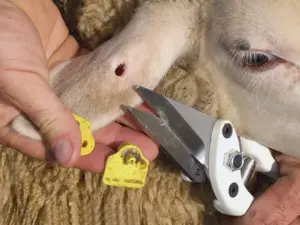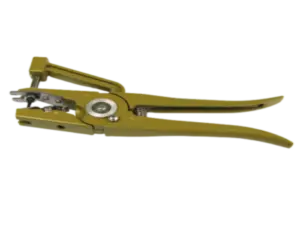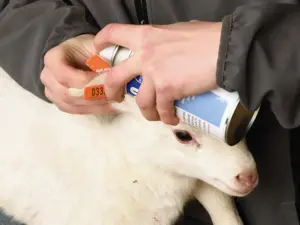Introdução:
Livestock ear tags are essential identifiers. But their removal requires careful consideration to ensure the animal’s safety and well-being. Here’s a comprehensive guide on how to remove livestock ear tags effectively and safely.
Understanding Livestock Ear Tags

Livestock ear tags serve as identification markers. They provide crucial information about the animal’s origin, health, and ownership. They come in various types—plastic, metal, or RFID (Radio Frequency Identification) tags. Removing them demands different techniques based on the material and design.
Reasons for Livestock Ear Tags Removal
There are several reasons why one might need to remove an ear tag:
Damage or Loss
Ear tags can get damaged or lost due to wear and tear, making it necessary to replace or remove them.
End of Usefulness
Some tags become obsolete when an animal is sold or the information becomes outdated.
Animal Welfare
Tags might cause discomfort or injury to the animal, warranting their safe removal.
Livestock Ear Tags Removal- Tools Required

A livestock ear tag remover can do the job professionally. However, if you want to do it yourself, the tools necessary are:
Specialized Pliers:
For standard plastic or metal tags, pliers designed for tag removal work best. These pliers are equipped with specific mechanisms to cut or twist off the tags without causing harm.
Scissors or Blade:
In some cases, especially for damaged or loose plastic tags, scissors or a blade may be necessary to carefully cut and remove the tag.
Disinfectant:
Before and after removal, disinfect the area to prevent infection.
How To Remove Livestock Ear Tags: Step-by-step guide
1. Preparation
Ensure the animal is in a calm and controlled environment. Restrain or secure the animal to prevent sudden movements that could cause injury.
2. Assessment
Examine the tag and its attachment to the ear. Determine the type of tag and the best method for removal.
3. Use Proper Technique
Employ the appropriate tool or technique for removal:
- For Plastic Tags:
Gently hold the ear and carefully cut the tag with scissors or a blade. Avoid cutting too close to the ear to prevent injury.
- For Metal / RFID Tags:

Utilize specialized tag removal pliers. Grip the tag firmly, twist or cut it following the tool’s instructions. Take care not to pinch or injure the animal’s ear.
4. Clean the Area
After removal, clean the area around the ear with a disinfectant to prevent infection.
5. Monitor for Discomfort
Check the animal for any signs of discomfort or bleeding. If there are concerns, seek veterinary assistance promptly.
6. Dispose of the Tag Properly
Dispose of the removed tag appropriately, adhering to local waste disposal regulations.
Considerations for Different Tag Types
The answer to the question how to remove livestock ear tags depends on the type of ear tag. Different types of ear tags require specific considerations during removal:
Plastic Ear Tags
Plastic ear tags are commonly used and relatively easy to remove. However, they might become tight or embedded in the ear due to prolonged use. Here is what a livestock ear tag remover does when removing plastic tags:
- Checks for any tightness or embeddedness in the ear.
- If the tag is embedded, uses caution and consider seeking professional assistance to prevent injury.
- For loose tags, he/she carefully cuts them using scissors or a blade, ensuring you don’t accidentally cut the animal’s ear.
Metal Ear Tags
Metal tags are durable but can be challenging to remove due to their sturdy nature. Specialized tag removal pliers are necessary:
- Ensure the pliers are in good condition and specifically designed for removing metal tags.
- Use a steady hand to avoid pinching the animal’s ear or causing discomfort.
- Some metal tags might require twisting motions for removal, so follow the tool’s instructions carefully.
RFID Tags
RFID tags contain electronic components and require specialized equipment for removal. If removal is necessary:
- Consult with a professional or the tag manufacturer for proper removal procedures.
- Specialized RFID tag readers or deactivation tools might be necessary for safe removal without damaging the tag or harming the animal.
Livestock Ear Tags Removal Care

After removing the ear tag, observe the animal for any signs of discomfort or infection:
- Monitor the ear for bleeding, swelling, or irritation.
- Apply a mild antiseptic or disinfectant to the area to prevent infection.
- Keep the animal in a clean environment to minimize the risk of contamination.
Preventative Measures
A livestock ear tag remover suggests the following preventive measures to avoid the necessity of frequent tag removal:
- Regularly inspect tags for damage or signs of discomfort in the animal.
- Use proper tagging techniques initially to prevent tags from becoming embedded or causing discomfort.
- Consider alternative identification methods like electronic tagging systems that don’t require frequent removal.
Safety Measures and Considerations
- Avoid Hurting the Animal: Exercise caution and gentleness throughout the process to prevent causing pain or injury to the animal.
- Follow Guidelines: If you’re unfamiliar with tag removal, seek guidance from a veterinarian or an experienced professional.
- Anticipate Challenges: Some tags might be harder to remove due to tightness or damage. Proceed slowly and carefully to prevent further complications.
- Keep Records: Maintain accurate records of tag removal, noting the reason and date for future reference.
FAQs- How To Remove Livestock Ear Tags?
How do I determine the best method for removing a specific ear tag?
Different ear tags (plastic, metal, RFID) may require distinct removal techniques. Assess the type of tag by examining its material, design, and attachment method. Plastic tags may need cutting with scissors, while metal tags often require specialized removal pliers. For RFID tags, consulting the manufacturer or a professional for guidance is advisable.
Can I remove ear tags myself, or should I seek professional help?
While some ear tags can be removed by livestock owners using appropriate tools and techniques, seeking professional help, especially for embedded or challenging tags, is recommended. Veterinarians or experienced individuals possess expertise in safe removal methods, ensuring minimal discomfort for the animal and preventing potential complications.
What should I do if an ear tag is embedded in the animal’s ear?
Embedded ear tags require extra caution to prevent injury to the animal. Attempting removal on your own may cause further harm. Seek immediate assistance from a veterinarian or a professional with experience in removing embedded tags to ensure proper and safe removal without causing additional discomfort to the animal.
Are there any risks or complications associated with removing ear tags?
Improper removal techniques or tools can cause pain, bleeding, or infection in the animal’s ear. Additionally, attempting to remove embedded or tightly secured tags without expertise may lead to injuries. Careful handling, proper tools, and, when in doubt, seeking professional help can significantly reduce the risk of complications.
How can I minimize discomfort for my livestock during and after tag removal?
Prioritize the animal’s comfort by working in a calm and controlled environment. Use proper techniques and tools to minimize pain or injury during tag removal. Post-removal, monitor the animal for signs of discomfort, apply disinfectant to the area, and keep the animal in a clean environment to prevent infection and promote quick healing
Conclusion:
We hope you have now understood how to remove livestock ear tags. Removing livestock ear tags is a delicate process that demands care and precision. Prioritize the animal’s safety and comfort throughout the removal procedure. By following appropriate techniques, using the right tools, and considering safety measures, you can effectively remove ear tags while safeguarding the well-being of your livestock.
